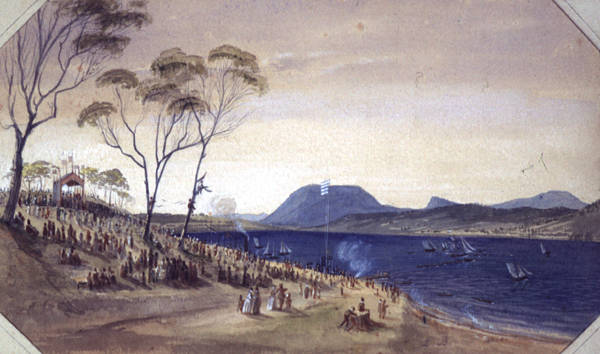 |
 |
|
German Community
For the purpose of this entry, people whose parents' first language was German are referred to as Germans, for neither a unified Germany existed before 1871, nor did all the German-speaking people in Van Diemen's Land come from the geographical area which today constitutes Germany. Even before Van Diemen's Land became a British penal colony in 1803 German adventurers reached the island. The very first German who saw Van Diemen's Land may well have been Captain Yde T'Jercxzoon Holman, the brother-in-law of Abel Tasman who captained the Heemskerk in 1642. The first pictures of Tasmanian Aboriginals were drawn by the Swiss artist Johann Wäber who accompanied Captain Cook in 1777.1 German settlers arrived in Van Diemen's Land from the 1820s. Having been granted land in Van Diemen's Land, the descendents of Baron von Stieglitz arrived in 1829 and assumed prominent roles as pastoralists, as did the Von Bibra family. The German artist Ludwig Becker, who perished in the Burke and Wills expedition, spent almost two years in Van Diemen's Land painting some forty beautiful watercolours in 1851/2. Between 1855 and 1872 several ships mostly from the port of Hamburg brought about 2000 immigrants from Germany to Tasmania. These early settlers were mainly fruit-growers and market-gardeners.2 In the 1870s Germans and Danes were enticed by the Tasmanian Government to come to the colony by offering them assisted passages and free land. Most of them were Lutheran, establishing a Lutheran congregation in Bismarck near Hobart. Heinrich W Ferdinand Kayser was appointed General Mine Manager at Mt Bischoff mine near Waratah, a position he held for 32 years. In 1903, the American-born German Robert Sticht became the General Manager of the Mt Lyell mine and built the Queenstown smelter.3 With the onset of the First World War the early German settlements Bismarck and German Town (in the north of the state) were renamed Collinsvale and Lilydale respectively. In response to the war a number of Germans were interned at the Quarantine Station on Bruny Island and others, though not all, suffered some discrimination.4 The Austrian naturalist Gustav Weindorfer, who arrived in Tasmania in 1906, worked tirelessly for the establishment of the Cradle Mountain National Park. The engineer Otto Koerbin, whose father had migrated to Tasmania from Germany in 1872, was involved with the construction of Waddamana dam and served as Power Station Superintendent after the war.5 During the Second World War Germans, Austrians and others faced restrictions and a few Germans, with 120 Italians, were interned at Butlers Gorge where they were put to work on the hydro-electric dam. The aftermath of the war saw a new wave of immigrants from German-speaking countries. Many of these helped complete the Tasmanian hydro power stations. While in the early years Lutheran communities were cared for by visiting ministers from the mainland, in 1952 the first resident Lutheran minister was appointed in Hobart. He was to serve the whole of Tasmania, until a second minister was appointed to live in Launceston in 1959.6 The German Australian Association, founded in 1962, became a meeting place for many German speakers who arrived in Tasmania after the Second World War. In 1966 the German painter Wolfgang Grasse migrated to Australia, he now lives in Penguin, in northern Tasmania. The Austrian painter Anton Holzner made Tasmania his home in 1971.7 The best know contemporary Tasmanian of German extraction is the writer Christopher Koch. Germany (1960s), Switzerland (1968) and Austria (2001) are represented at consular level in Tasmania. In the 2001 census 1363 respondents in Tasmania indicated that they spoke German in their homes. Further reading: G Appeldorff, Memories of Collinsvale, Collinsvale, 1986; R Lupton, Lifeblood, Sydney, 2000; C Meyer, A history of Germans in Australia 1839–1945, Melbourne, 1990; S Wegmann, The Swiss in Australia, Grusch, 1989; M Bardenhagen, Lilydale, Newnham, 1993. Eva Meidl Footnotes: |
Copyright 2006, Centre for Tasmanian Historical Studies |
